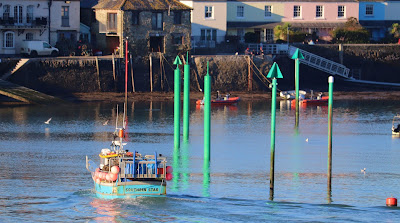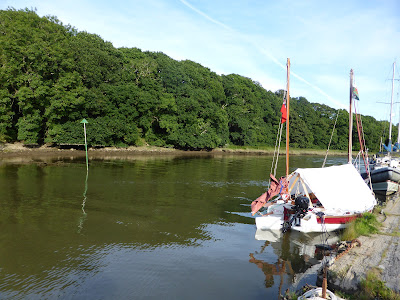Videos on the cruise up the Lynher and Tamar can be downloaded as a playlist from here
Approaching Treluggan
In the middle
of the confluence where the rivers Tiddy and Lynher merge, lies an incongruous
sight; an isolated single upright scaffold pole with an upside-down makeshift
sign pointing ‘This way to Treluggan
Boatyard’.
For boaters
and sailors who don't know these waters, this amusing sign provides reassurance
that one is heading in the right direction for the boat yard.
To those in
the know? The boat sign is upside down and pointing completely the wrong way.
It is the product of some mischievous soul’s humour. Follow the sign and the
intrepid waterborne explorer will merely meander up the last section of the
river Tiddy and arrive at St German’s quayside. Not that this is an unsavoury
prospect in any way. It is a beautiful quayside with a large Victorian viaduct
beyond, scenic quayside cottages and lime kilns and a rather welcoming small
yacht club house. It is not, however, the aforementioned ‘boat yard’.
Such musings
on ‘signage’ are not helping the skipper of the small white hulled 14’
lapstrake yawl out of his self-inflicted predicament, however. But, at this
moment in time, there is little else to do but admire the scenery, muse about
upside down signposts and be thankful that the only observers of his current
debacle are a flock of Brent geese, two egrets and some crows high in the tree
branches above. He suspects they are gossiping about him!
Stuck on some
boulders and weed beds at the end of a muddy beach which leads up to a little
salt-flat marsh, his rudder is wedged between rocks and weed clumps. It is a mere temporary state of grounding!
The tide still builds steadily and skipper knows he will float off at some
stage in the next twenty minutes or so. After all, he had the foresight to plan an
exploration of new waters on a rising tide because of this potential eventuality.
Oar pushing
and boat rocking have failed to move the open boat and so, after a few minutes
of strenuous activity in the hot afternoon sun, skipper has decided to let
nature take its course. He will wait awhile and hope to float off. In the
meantime, like many a skipper before him, he replays the previous minutes
leading up to the grounding and ponders the inevitable key question…………… ‘What happened - it was going so well?’

The gentle breeze
pushes the little John Welsford designed ‘navigator’ yawl on a downwind run up
past Erth Island marshes. The mizzen, almost fully out over the port transom
quarter, flutters occasionally, its sheet tugging through boomkin block, causing
the inboard end to rattle gently against the wooden securing loop under the
port aft side deck. It is a familiar sound to skipper. The long loop of slack
mainsheet hanging vertically from the aft end of the sprit boom occasionally dips
down, dragging in the water; adding ‘ripples’ to the gurgling soundscape
running alongside the boats lapstrake hull.
Lazy summer
days drifting along on a flood tide. How glorious.
A swift glance at the little
yellow waterproof notebook with its hand drawn pilotage maps and annotations
confirms Skipper’s thoughts. “No need to
rush, pointless entering the upper Lynher before 1530pm”. A scrawled annotation reads “enter/exit upper Lynher 1.5 hrs +/- high
water”. Pre-trip research done a few days ago. Drawing only 20” or so with the centreboard
and rudder fully down, the welsh sailor quickly calculates tidal heights in his
head and concludes that he could indeed enter the channel now, at 14.30; after
all high tide is at 1654 and is 4.9m. There should be enough channel depth even
if the tide hasn’t completely filled the channel yet.
He turns a
little to starboard towards the upper Lynher entrance and winds shift around to
come over his starboard aft beam putting him on a reach. Lowering centreboard a
little more, he hauls in the mainsheet a wee bit and the boom, carried by the breeze, settles a
couple of metres over the port beam. The rudder is fully down and although
mudflats are still exposed on either channel side he should have plenty of
water under the hull mid channel and enough room to do some short tacks upriver
if needed.
There is no
rush. Arwen, the little white yawl with her tan sails, glides northwards, her
lone occupant beguiled by gentle breezes and blue skies, the high-level stratus
clouds and balmy temperatures of 28C. Relaxed and contented, he drifts along, pushed by the merest whisper of breeze and tidal current.
Reaching for the binoculars
from their customary place behind the backrests, under the starboard side deck,
he sweeps them left to right; a gentle arc searching out the channel marker
poles beyond the lone humorous, mis-directional signpost. He chuckles to
himself about some soul’s mischievous nature and sense of fun.
Optical depth
of field brings the low gently sloping hills of Devonian slates and grits with
their improved grassland pastures, Cornish hedgerows and scattered clumps of
sessile oak woodlands beyond the muddy shingle beaches and marshes into focus.
An unusual
feature, skipper reflects, are the areas of intertidal mudflats and marshes.
Unusual, because this is a flooded Ria valley and marshes this far up are not a
normally expected geographical feature. Their flat surfaces, covered by
thin wavy grasses and bisected by tiny creeks and gullies add interest to the
scene before him. Geographical oddities, their normal bright green colour
replaced by a drought induced wilted yellow/beige shade which glistens silvery when blown in
certain directions.
As the little
yawl pushes forward at 1 knot or so, the sailor moves forward to unclip his
paddle from the front port fore deck area before returning aft to check that the
oars resting in their rowlocks along each side deck are ready to be deployed. He knows that the local topography around this
part of the river has a deceptive influence on gentle breezes. They spill off
slopes in sudden shifts of wind direction. At times, they can die completely,
blanketed by thick shoreline oak woods; leaving a little boat becalmed; to
drift at the mercy of tide and river current.

On this
particular trip, skipper has vowed not to, under any circumstances, start the
outboard motor hanging off the bracket on the port side of the transom. It is to be three
days continuous sailing without using the outboard, once initially clear of the
launch site in busy Sutton harbour. Thus far, and feeling rather proud about
it, he has managed to keep that aim going; sailing through the Torpoint chain
ferries and the long trot lines of moored yachts and successfully picking up
and departing from a mooring at the entrance to the Lynher river. He has every
intention of sailing right onto the pontoon at Treluggan boatyard later on this
early evening. “No motor on this trip.
Just not happening” he whispers to himself and the heron standing
motionless at the water’s edge.
Of course,
some would say, in order to guarantee this aim, “Leave the motor at home” To
which the reply is always the same…………”Some
day; when I have had more experience of river cruising in a wider variety of
conditions; and better faith in my own abilities; maybe then. And anyway, it
adds some useful ballast!” Skipper has lost some two stone in weight this
year. He’s very pleased with this; and he knows that Arwen best sails with around
one stone of ballast for every foot of boat length. The outboard engine is the
extra ballast required! Or so he kids himself!
As the murmuring
breeze further ebbs away, both snotter and downhaul are eased, the sprit boom moves
slightly forward and more ‘bag’ appears in the mainsail. Arwen gains a marginal
increase in forward momentum but soon the jib flutters and falls limply across
the foredeck, its sheets gently rattling the side deck blocks. Skipper hauls on
the thin red line leading to the bowsprit furler and the jib obediently furls.
For now, it is useless.
Closing on what
will be the first of many channel marker poles, he reaches for a
water bottle from one of the aft cockpit halyard bags. Cheese and marmite
sandwiches are retrieved from a neighbouring bag and with forearm resting on
tiller to maintain some semblance of steering direction, refreshments are
taken. Not fully sure of the channel
ahead despite his pilotage research, note taking and scrutinising of google
earth and local charts, he anticipates that manoeuvring room may be limited, the final approach up to the yard uncertain
and so it seems prudent to eat and drink now in the wider water area of the
confluence.

The makeshift
signpost is passed; the red and white stripped port marker pole comes abeam. The
starboard green and white pole with its rather marked upstream lean, falls slowly
astern. The lone sailor makes a course adjustment and fortuitously the breezes unexpectedly
reappear. That ‘cheeky’ local topography! Now, coming from the port aft quarter,
the boom idly eases across in slow motion to the starboard side. The rattle of
boomkin and block confirms the mizzen has done likewise. He quickly glances
over his shoulder to confirm that its sheet has cleared the raised outboard
engine and the petrol cap that has so often fouled the sheet in the past. All
is well. The next port marker falls
astern. The last leg, the final approach has been started. From now on this is,
for skipper, uncharted territory. He has sailed many times to St German’s but
never up the Lynher to Treluggan. It’s a
new adventure! It’s quite exciting!
Centreboard is
lowered a mite further and skipper keeps a wary eye on waters ahead. Steep,
exposed mudbanks stretch down from marshes on the Erth island side to the east.
His eyes flick constantly from sketch map in notebook to view ahead, as he
mentally ticks off identifiable pilotage features. He navigates by marker poles,
ticking them off one by one, criss-crossing the channel from side to side,
keeping to the outside of the bends. Positioned on the port side thwart to gain
the clearest view ahead of the closing western shoreline, he’s already checked
that the little lifting cam cleat securing the rudder downhaul is free and
ready to lift should the rudder hit bottom. Centreboard downhaul has been
released; it should bob upwards into the case on first contact with any
obstruction below.
The
occasional flap of the main sail luff, the gurgling of waters trickling
alongside the hull; the harsh cackles of Brent geese somewhere ahead lull the
boats occupant into a hypnotic state; so, he is somewhat startled by the sudden
flap of wings and cries of the rook departing the top of the starboard marker
pole ahead. Too close to that pole for his liking and with rising rafts of weed either side of it, he
realises he is running out of water depth. He nudges the tiller towards the
pole and Arwen’s bow heads out towards the centre of the narrowing channel. He
closes more slowly on the port marker pole on the opposite side of the channel.
He is wary once again.

The brush
with the shallows did, however, afford him fabulous views of the Erth Island marsh
hinterlands. Motionless white egrets in little gullies and dry sea grasses and
reeds sighing in the breeze. A buzzard
lifting off the marsh 30 ms inland. A few hundred metres beyond the seaward edge
of the marsh, a tree and hedge line and then the sloping Cornish hills. As a
geographer he appreciates the vital role these upper salt marshes have in the
ecology of the area. Home to 6000 or so fowl and 10,000 wading birds; a vital
overwintering feeding spot; a zoned landscape of mudflats, salt marshes,
freshwater fens and wild oak woodlands. He
enjoys the utmost peace, tranquillity and charm such places bring.
He skirts the
next port marker, sailing close inshore, past the rear of a neighbouring salt
marsh and its little beach where a low black hulled barge is moored. High and
dry on the upper marsh tussocky vegetation, it is firmly moored fore and aft
with thick silvery hawsers, their lower portions a washing line for dried
seaweed and assorted plastic flotsam. Seemingly abandoned, closer inspection
shows it is well maintained and used at times, for windows and portholes are
covered with faded curtains and bleached canvas outdoor chairs rest against the
low cabin walls. Perhaps it is a holiday retreat, a place to escape the
vagaries of a busy lifestyle.
A grating
sound.
The boat lurches jolting Skipper out of his reverie. No warning thump of the centreboard hitting
its centre trunk cap; no ‘click’ signalling the lifting of the quick release
cam cleat on the tiller. A hasty glance over the transom confirms skipper’s worst
fears and suspicions. He is aground. Marooned on some weed covered boulders just
beyond the channel port marker pole. How
ironic! The rudder, surprisingly, appears
jammed, unable to float upwards. Skipper releases mainsail halyards, dropping
the sail into the boat; he does likewise with mizzen. Pushing backwards on an
oar placed on both sides of his boat has no effect. Rocking side to side fails
likewise. He contemplates jumping overboard into the 18” or so of water beneath
the hull. The footing appears to be thick mud and scattered boulders; the
water surface is murky and weed covered; a bladder wrack forest! Um! Maybe not.
‘Serves me right’ he says to himself. “Less time admiring the view, more focus on
what I’m doing and next time be aware of the soporific effects of the sun!”
Skipper chastises himself for making such an elementary school boy error!
But he soon relaxes,
safe in the knowledge that the little boat will be lifted off by the remaining
tide and with luck and good fortune, the rudder will then un-jam and float
upwards. The centreboard has been raised, sails have been collapsed and
temporarily tied. For the next twenty minutes or so, patience is needed.
He explores
his immediate surroundings. Ten metres away, on a gently sloping shingle mud
mix beach, sentinel Brent geese eye the boat and its poor watching
keeping skipper with suspicion. On the grassy low bank beyond, other geese
graze, a few gulls strut about and ever watchful crows discuss the skipper’s
antics in a series of shrill ‘clawc’s’. The boat has beached just off an old
long forgotten low quayside; a few rotting vertical wooden poles all that
remain of a once wood protected low quay wall. Mud built up over the century or
so makes what remains of the wall very low indeed. Driftwood litters the grassy bank; some
larger logs bleached silvery grey by years of weathering. An erect heron regally surveys the scene from one of the driftwood tree branches.
And so, it
comes to pass.
A foot or so more tidal height and Arwen floats off the boulders
and weed raft. Using an oar, skipper pushes back and fore until the little
white boat eventually moves backwards. The rudder rises upwards adorned with
weed and a few new scrapes in its white paintwork. Grey scars and gashes, a rather
nasty looking gouge but close inspection shows the bottom layer of fibreglass
cloth has held and not been damaged. Water tightness has been maintained. But
it is a ‘workbench job for when we get
back’ thinks skipper.
Standing in
the forward port side part of the cockpit, he paddles his boat out into the
channel and raises the mainsail. It flutters and fills, setting on the
starboard side. He takes a chance, raising both mizzen and jib and the little
boat glides forward across the channel towards the next starboard channel
marker pole. Ahead, as he rounds the slight bend, the railway viaduct hoves
into view. Skirting the western channel side, this time acutely aware of
seaweed clumps and sticking up branches in the channel, he slowly glides
upstream. Alongside him, hills slope down to wire fences and tree canopies tower
above his sails, dangling over the small river cliffs and casting occasional shadows
over the rocky beaches below.
The river
surface is mirror calm, only the occasional ripple betrays the presence of a
breeze. Ahead, the symmetrical arches of the Victorian Brunel designed railway
viaduct, a testimony to Victorian ingenuity.
The purple coloured brick parapets, resting on what appear to be large
granite support pillars, are covered with grasses and small buddleia bushes;
white lime streaks adorn the ceilings of the inner arches where mortar and
water have mixed and precipitated out over the years. The slowly setting
afternoon sun casts shadows on the upper inner archways and the river surface
beyond the viaduct.
Skipper
checks the wind direction and speed and mentally plots his course for the
middle span. The ‘fairway’ is marked by white squares on two neighbouring
viaduct pillars; each white square having a square of red or green paint within
it. Clear channel markers. His paddle rests across the starboard side thwart;
he is drifting, the sails barely fill. Carried by the last of the incoming tide
and faintest of breeze, he approaches the central arch. He knows his raised
sails will clear with several metres above to spare yet from his current
position, that arch just doesn’t look high enough. It is now a matter of faith! Faith in his calculation of tidal
heights and archway clearances. Faith, that the breeze will hold.
He moves
further forward. The mainsail sags, the sprit boom hangs listlessly and
lolls inwards. Ten metres to go. The trees on the western bank have caused a
wind shadow. There is no breeze. The jib, once again, hangs forlornly over the
fore deck. The mizzen just tends to itself, amidships. Three metres to go.
A startled
cormorant sunning itself on the bottom wedge shaped buttress at the foot
of the western archway pillar takes off and skims across the water down the
side of Arwen. By now the fore deck is
under the arch span. The coolness of the air and the shadow within make skipper
shiver involuntarily. He cranes his neck back to inspect the roof top above as
a small three coach train rumbles overhead.
And then boat
and sailor are through and a new world has appeared. On the western shore, a
large tidal salt marsh, backed by a small hill and remains of a tree covered
large quarry site. Incongruously, between the trees, scattered aluminium masts
stand straight and glittery in the early evening sunshine but hulls below remain hidden by vegetation.
Along the
seaward fringes of the marshes lie an assortment of large barges and boats.
Live-aboards, in various states of repair and conversion. A black hulled Dutch
barge with red top strake and rear cabin, its green hatch covers reflecting the
light. An old WWII motor torpedo boat with its blunt, near vertically faced
cabin structure and long sweeping bow. Its stern deck is covered with off white
awnings and frames; the metallic lattice work that held lights and signal
halyards and perhaps even radar, rusted and pitted. Beyond these ancient
vessels, the first glimpse of an old wooden pontoon, low on the water surface,
arcing out and away from the shoreline, its outer end indicated by a small
white cabin sail boat moored to its inner side.

Whoosh!
Unnoticed by skipper, the mainsail had swung over to the port side during the
passage through the viaduct archway. Now, out of the wind shadow cast by this
structure, the sail with its sagging sprit boom shoots viciously across the
boat to the starboard side, clearing skipper’s head by a mere inch or two at
best. He is a lucky man. His reactions are first rate although he doesn’t
appreciate the face plant he executes onto the back of the rear centreboard
casing. Whilst his skull remains undamaged, the thought of a possible deep forehead
impression mark cast by the jib sheet cam cleat he hit, worries him. It will be
embarrassing arriving with a dent in his forehead! He rubs the affected area
gingerly and once again curses himself for being ‘lured’ by the landscape
beauty! Another valuable ‘repeat’ lesson……”
keep your eyes on the sail and wind not the scenery”.
Less than 50
metres to go. His perusal ahead shows that there is insufficient water in the
channel for him to execute a turn that would bring Arwen’s bow facing
downstream when he ties up at the pontoon. It will be a downwind arrival onto
the pontoon then. There is insufficient wind for it to be by jib or jib and
mizzen alone and so he opts for a mainsail approach. Jib and mizzen are duly furled.
He can always drop main closer to the pontoon and arrive using paddle if need
be. After assessing his approach, the sailor leans forward and adeptly deploys
three black fenders along his port side; he moves the bow and stern warps
closer to hand on the thwart top. He is ready.
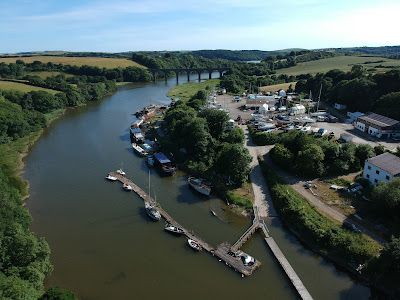
Passing the small
closed off creek to his starboard side, with its withies, planted in giant X’s across
the channel entrance, he admires the fetching black hulled yacht that has been
pulled up onto the shore. Its bow points up the sloping hillside, wooden legs support
its sides and the stern is tied off to two mooring poles, upright in the
shallows. A long warp from bow to convenient tree secures the front and the
mast has been raked back slightly to avoid the overhanging oak tree branches.
Tarpaulin covered, with black mould and lichen marks everywhere, the pretty
little yacht has clearly been ashore for some time.
Arwen creeps alongside
the Dutch barge with its little smoke stacks between hatch covers; she slides
past the MTB, its grey paint rust stained.
Skipper eases her over to the starboard channel side as a 35’ ketch
suddenly appears as if from nowhere. He didn’t see her and so he is momentarily
caught off guard. Her masts must have blended with those ashore and she’d been
hidden by the boats moored on the outer end of the pontoon. But no worries, for
there is sufficient room for this boat and Arwen to pass each other. The boat’s
skipper throttles down as he passes the little open dinghy. Courteous
greetings, smiles and waves are exchanged and Arwen’s bows lift and bounce over
the small wake.
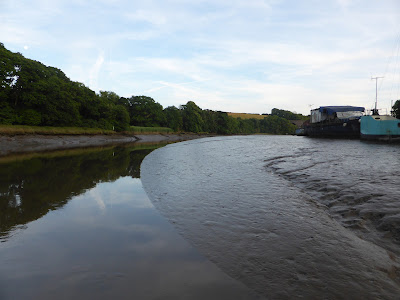
With barely any
breeze now present, the dinghy’s skipper eases her alongside the moored boats on
the outer edge of the pontoon and past the last grey rib. A quick flick of the
tiller to starboard and the little dinghy comes alongside. Main sheet is
released, mainsail halyard uncleated and the sail drops with alacrity into the
boat. The little boat drifts a few feet to a stop. In one fluid movement
skipper has stepped ashore with bow warp and before he knows it has secured it
through an iron loop on the wooden pontoon. The stern warp is secured likewise
and skipper steps back aboard to raise the rudder. Standing in
the rear cockpit, skipper suddenly remembers it is time to breath again. It is
a first. He has managed to sail from the Cattedown to the Treluggan boat yard
pontoon without recourse to the outboard. For normal sailors, this is an
unremarkable feat! For this sailor, it is an achievement.

Stepping once
more onto the rickety pontoon of what suspiciously look like old interlocking railway
sleepers, skipper re-positions fenders and calculates what length of warp he
needs to set. The tide is at its highest. In a half hour or so it will turn. He
knows that at low tide the mud banks to his right will be almost 2.5m above him
when they meet shoreline and the width of water in the channel will be a few
metres at best. He thinks his boat will rest on the bottom overnight or float
in only a few inches of water. Gambling that the pontoon probably has a
four-foot depth to it, and that it will dry out on the bottom at low tide, he
adjusts for enough slack in the warps and rigs a spring line as well.
With boat
secure, he stretches his legs by walking the length of the pontoon. Black brown
and gouged, where wood has rotted away, it is indeed a series of smaller wooden
pontoons chained together. Their surfaces are covered in nailed down chicken
wire to provide grip. Grasses grow in crevices along the outer edges; the
occasional shrub grows on the inner edge. Electric cabling runs loosely along
the surface on the outer edges. A mixture of new and old iron bollard cleats
and loops provides mooring fixings. It is antiquated, serviceable and rather charming.
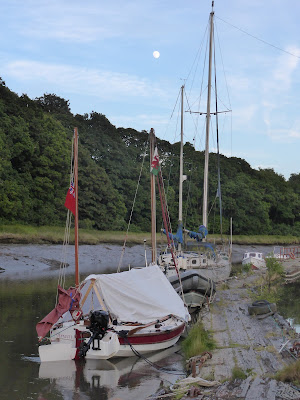
Soulful but
uplifting country music drifts across the scenery from one of the live-aboard
barges, accompanied by laughter and tinkling glasses. It isn’t obtrusive, rather
the opposite, homely and welcoming. Skipper ambles back along the deserted
pontoon to where an iron girder footbridge rests, its other end linked to the
grassy bank by the concrete slipway. To one
side lies an inverted 6’ tender rib, a small fibreglass dinghy, some old
tarpaulins, a few tyres and a small portable petrol generator. A coiled yellow
hose pipe hangs on a bracket. On the outer pontoon edge, a space reserved for a
harbour launch, old white fenders protect pontoon sides and ducks drift alongside; the water beneath gurgles in little eddies and rivulets.
On the inside
of the pontoon, a shallow, mud filled lagoon with an old wreck. The transom, a
few planks and one side panel all that remain of a small old cabin cruising
boat, now breaking the surface of the greeny waters.
It is time to
check in at the boatyard office. Then a boat tidy and an explore of boatyard
and quarry before assembling the tarp tent and cooking an evening meal. The local
ducks float up to skipper for a close inspection. He concludes that the evening
meal is clearly going to be a ‘shared one’.














